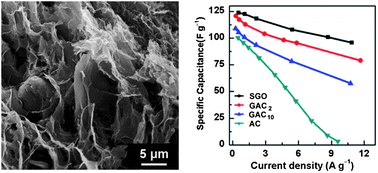Composite organogels of graphene and activated carbon for electrochemical capacitors†
Abstract
We report the preparation of composite organogels of reduced graphene oxide (rGO) and activated carbon (AC) by a solvothermal reaction and their application as electrodes of electrochemical capacitors (ECs). In these organogels, rGO sheets are assembled into a 3-dimensional (3D) framework for encapsulating AC particles. The 3D interconnected rGO network increased the electrical conductivity and the AC component provided high specific surface areas (SSAs) for the composite organogels. These composite organogels also have stable mechanical properties and can be directly used as electrodes of ECs without using any binding agent and conducting additive. In a practical two-electrode system, the specific capacitance of the ECs based on the composite organogels was tested to be 116.5 ± 2.2 F g−1 at a current density of 1 A g−1 in an organic electrolyte of propylene carbonate (PC) containing 1 M


 Please wait while we load your content...
Please wait while we load your content...